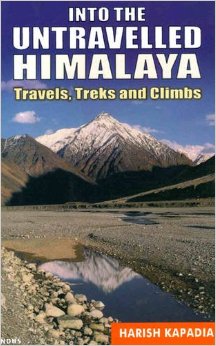To get the full value of joy you must have someone to divide it with ~~ Mark Twain

Into the Untraveled Himalaya, Kapadia H
The best thing about a Himalayan journey, irrespective of how high above the MSL you reach, is companionship. And that’s what ‘Into the Untraveled Himalaya‘ is all about. Harish Kapadia, the author, talks about his companions, guides, friends, and Himalayan acquaintances in this book.
The book talks about Kapadia’s porters from Kumaon (who accompanied him from Siachen to far east Arunachal), his sherpa friends ( Tiger Sherpas, three of them), Nain Singh (the incognito Surveyor in Tibet), Sir Chris Bonington (who climbed a 5480m peak in Pangi Valley in 2004. Bonington was 70 years old in 2004), and several other friends Kapadia made over the years in the mountains.
This is essentially a people’s book.
The book chronicles travels by Mr. Kapadia over a mountaineering career ritual spanning over 31 years. A business merchant from Bombay talks about all that he has learned over the years from the mountains and its people in this book. Unlike his other books, this book focuses more on people and not the mountains.
Primarily divided into 19 chapters, this book starts from the Roof of the World and then gradually explores the other mountain ranges in and around India. For me, who has never trekked in the Himalayas outside Himachal, this book is a brilliant guide book that not only throws light on the historical explorations of Himalayas outside Himachal but also highlights popular as well as unexplored trails of the far-off regions.
The journeys to Bhutan, Tibet, and our very own Arunachal have been described vividly. The mysterious journey of the Tsangpo and exploring the Tsangpo bend in Arunachal are some key highlights from Arunachal. As the author explores the beautiful little state of Sikkim, under the shadow of Mount Kanchenjunga, you get a feeling of being a companion on this awe-inspiring journey across the North Eastern frontiers of our nation.
In between, you will find the author talking about his companions who made his Himalayan exploits successful, over the years. Here’s some of the excerpts from the book that will literally force you to find(because either out of print or too expensive) this book and read it.
Among three of them, mules, jerry cans and helicopters, they rule the Karakoram Trails. Without these rajas, no praja can survive this harsh environment. But the supreme king amongst them, unquestionably, is the mule.
They don’t tell, they don’t swell, they don’t yell,-these Kings of Karakoram do it damn well.
Nain Singh, the incognito Survey of India man who stayed undercover and worked in the prohibited lands of Tibet from 1874-75 also finds special mentions in the book.
[Pundit Nanin Singh] was allowed to proceed and reached Udalgiri in the British territory of Assam on 1st March 1876, completing an exploration of 1405 miles between Leh-Lhasa-Tawang-Assam.
Surprisingly (and sadly too) the author forays into the Land of Passes (Bada Bhangal) quite late in his life and probably that’s why we find no mention of any name as the author walks through the beautiful meadows of this remote land in the Kangra Valley. However, journeys in the remote Himachal with Sir Chris Bonington (at 70), make a heartwarming read.
To give credit where it is due, Chris, who, a day before, was running as if the Indian Air Force was after him, walked with all of us as slowly as a revenue official inquiring about taxes in the villages, the next day.
That was the hallmark of a true mountain lover.
Then there are stories of the first Indian exploration of the Nanda Devi Sanctuary. Numerous such stories from e the entire length and breadth of Indian Himalaya are certainly a treasure trove.
With 23 maps and 48 photographs and many references, this book surely serves as an invaluable guide to future mountaineers and trekkers.